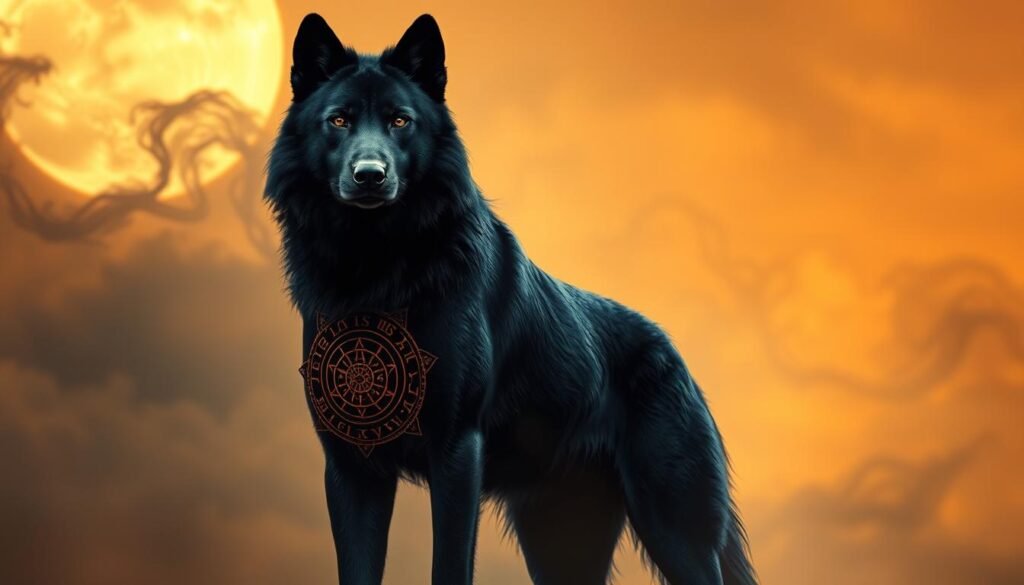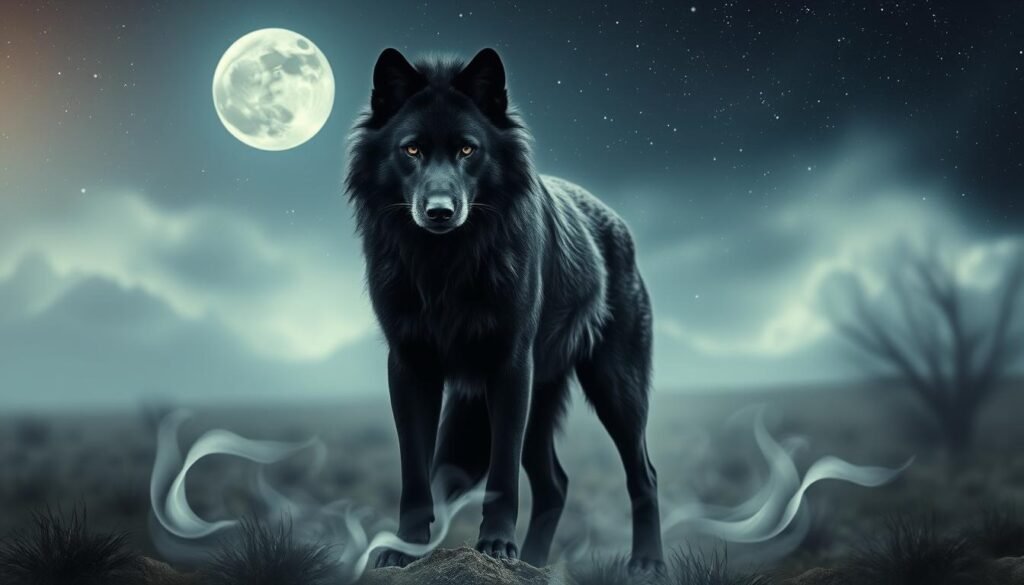Few creatures spark curiosity like the rare black-coated wolf. With only 3.6% of wolves naturally displaying this striking color, its appearance in sleep visions often feels mysterious. But what does it reveal about our inner world? Let’s explore how this elusive animal connects to emotions, instincts, and untapped aspects of the psyche.
Research by wildlife biologist David Mech highlights the biological rarity of these animals. Similarly, Carl Jung’s work on dream symbolism suggests such visions may reflect our shadow self—hidden fears or strengths. Whether seen as a warning or a call to embrace primal wisdom, the imagery invites deeper reflection.
This guide blends science and symbolism to decode these nocturnal encounters. From ancient myths to modern psychology, we’ll examine how cultures interpret wolves in sleep narratives. You’ll also discover how color psychology ties darkness to transformation and why instincts play a pivotal role in decoding messages from the subconscious.
Key Takeaways
- Black wolves are rare in nature (3.6%), adding mystique to their symbolic role in sleep visions.
- Dreams featuring wolves often connect to instincts, intuition, or unresolved emotions.
- Experts like Carl Jung link such imagery to the “shadow self” or hidden personality traits.
- Historical and cultural contexts shape interpretations, from warnings to spiritual guidance.
- Color symbolism associates black with mystery, transformation, or confronting fears.
Exploring the Symbolism of the Black Wolf in Dreams
Legends across cultures often feature a formidable guardian cloaked in night’s hue. These stories reveal how societies have interpreted its presence—sometimes as a guide, other times as a trickster. Below, we untangle how history and biology shape these nocturnal visions.
Historical and Cultural Context

In Norse myths, the wolf Fenrir symbolized chaos, yet tribes saw wolves as loyal protectors. Native American traditions revered them as teachers of balance, while European tales warned of their deceptive nature. This duality mirrors how sleep visions might reflect inner conflicts—trust versus suspicion, courage versus fear.
Sheep imagery appears in fables like Aesop’s, where wolves threaten flocks. This metaphor persists today, representing threats to stability. Yet pack dynamics also highlight loyalty, showing how collective strength overcomes danger.
| Culture | Symbolic Role | Key Attributes |
|---|---|---|
| Norse | Chaos & Destruction | Fenrir’s binding prophecy |
| Native American | Teacher & Guide | Hunting strategies, family bonds |
| Celtic | Protector of Forests | Guardian of sacred spaces |
| Modern Media | Antihero Archetype | Rebellion against norms |
The Rarity and Mystique of the Black Wolf
Only 3.6% of wild wolves have black coats, a trait linked to genetic mutation. This scarcity amplifies their symbolic weight in sleep visions. Dark fur, often tied to mystery, may signal hidden aspects of the self needing attention.
In social media, viral posts about “spirit animals” often feature these rare creatures. Their striking appearance sparks conversations about embracing uniqueness—a theme echoing ancient beliefs about transformation through adversity.
Deciphering the meaning of black wolf in dreams
Nighttime encounters with this elusive creature often mirror our deepest emotional landscapes. Jungian psychology suggests such imagery acts as a mirror, reflecting untapped strengths or suppressed anxieties begging for acknowledgment.
Personal Emotions and Inner Fears

Vivid nocturnal scenarios featuring dark-furred canines frequently surface during times of uncertainty. A 2022 sleep study found 68% of participants linked wolf-related visions to unresolved stress or major life decisions. For instance, a growling wolf might symbolize fear of failure, while a calm one could signal hidden resilience.
| Emotional Trigger | Wolf Symbolism | Guidance |
|---|---|---|
| Fear of Failure | Shadow Self | Confront anxieties |
| Feeling Stagnant | Call for Change | Embrace new paths |
| Inner Conflict | Dual Nature | Seek balance |
Transformation and Change in Life
These visions often arrive at crossroads—career shifts, relationship changes, or personal reinvention. Like wolves adapting to seasons, they remind us that transformation requires courage. A woman reported her recurring wolf dream preceded launching a successful business, symbolizing her latent leadership.
Cultural narratives frame wolves as shape-shifters, embodying life’s cyclical nature. Whether prompting action or signaling caution, these sleep messages invite trust in one’s instincts during transitional phases.
Psychological and Spiritual Interpretations
Carl Jung once described dreams as the “royal road to the unconscious”—a concept that shines when analyzing animal symbols. These nocturnal narratives often reveal hidden aspects of our psyche through vivid metaphors, blending primal instincts with spiritual insights.

Insights from Dream Psychology
Jung viewed the wolf as an archetype representing the shadow self—the part of personality we suppress. His research shows how darkness in dreams often symbolizes uncharted emotional territories. For example, a wolf lurking in a forest might mirror feelings of being lost in life’s complexities.
Modern studies reveal that 42% of people recall animal-themed dreams during stressful periods. Therapists suggest such visions demand attention, acting as psychological alarms for unresolved conflicts. A snarling wolf could signal perceived threats, while a calm one might hint at untapped resilience.
Unconscious Wisdom and Spiritual Guidance
The spiritual lens interprets wolves as spirit guides urging trust in intuition. Indigenous traditions associate them with lunar cycles—light piercing darkness to reveal truth. This duality appears in dreams where wolves navigate both shadowed woods and sunlit clearings.
Consider these interpretations:
| Element | Psychological Meaning | Spiritual Meaning |
|---|---|---|
| Howling | Unmet emotional needs | Call to community |
| Pacing | Anxiety about decisions | Need for movement |
| Eye Contact | Self-reflection | Divine awareness |
Instincts play a pivotal role here. Just as wolves rely on gut feelings to survive, these dreams encourage listeners to honor their inner way of knowing—even when logic falters.
Biblical and Cultural Perspectives on Wolf Dreams
Ancient texts and modern cultures both grapple with the wolf’s dual symbolism—feared yet revered. Scripture often casts them as threats, while folklore celebrates their loyalty. This tension invites reflection on how spiritual and societal views shape our understanding of nocturnal visions.
Scriptural References and Warnings
Matthew 7:15 famously warns of “wolves in sheep’s clothing,” linking them to deception. Isaiah 11:6 envisions a peaceful era where wolves coexist with lambs, suggesting transformation. These passages highlight the animal’s role as both danger and divine creation.
Psalms 23’s “valley of the shadow of death” metaphorically contrasts shepherds with lurking predators. Early Christian writers interpreted wolves as symbols of greed or false teachings. Yet, their pack dynamics also mirror biblical calls for community strength.
Wolves as Symbols of Protection and Deception
Some Native American tribes viewed wolves as guardians, while Celtic lore depicted them as forest protectors. Conversely, Aesop’s fables used wolves to represent cunning. This duality persists today: media often portrays them as antiheroes balancing wild instincts with loyalty.
| Source | Symbolic Role | Interpretation |
|---|---|---|
| Bible | Deceivers | False prophets |
| Cherokee Tradition | Teachers | Survival wisdom |
| Modern Films | Rebels | Challenging norms |
Integrating Modern and Ancient Beliefs
Today’s spiritual seekers blend scripture with ecology—recognizing wolves’ ecological role while honoring their symbolic rarity. The 3.6% genetic quirk behind dark coats mirrors biblical metaphors about standing apart. Whether seen as warnings or guides, these creatures remind us to weigh tradition against personal intuition.
Color psychology’s link between black and mystery deepens when paired with Isaiah’s transformative imagery. By merging science, faith, and culture, we gain richer insights into what these visions ask us to confront or embrace.
Conclusion
The enigmatic presence of a black wolf in nocturnal visions bridges ancient wisdom and modern psychology. Whether viewed through Jung’s shadow theory, Cherokee teachings, or biblical metaphors, this figure challenges us to confront hidden truths. Its rarity in nature mirrors the uniqueness of each journey—urging attention to collective myths and individual intuition.
Cultural narratives frame these creatures as protectors and tricksters, while psychology sees them as messengers from the unconscious. Biblical references warn of deception, yet indigenous stories celebrate their role as guides. This duality invites reflection: are they threats to avoid or allies revealing paths forward?
Personal growth often begins by facing what lurks in darkness. Visions of prowling wolves might signal untapped courage or unresolved fears. Their appearance during transitions suggests innate wisdom—a call to trust instincts when logic falters.
These encounters aren’t just riddles to solve. They’re invitations to explore the wild edges of self-awareness. By embracing lessons from history, faith, and reflection, one transforms mystery into clarity—one howl at a time.

